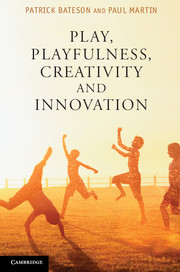Book contents
- Frontmatter
- Contents
- Advance praise
- Preface
- Acknowledgements
- 1 Introduction
- 2 The biology of play
- 3 The functions of play
- 4 Evolution and play
- 5 Creativity in humans
- 6 Animals finding novel solutions
- 7 People and organisations
- 8 Childhood play and creativity
- 9 Humour and playfulness
- 10 Dreams, drugs and creativity
- 11 Pulling the threads together
- Notes
- References
- Index
10 - Dreams, drugs and creativity
Published online by Cambridge University Press: 05 July 2013
- Frontmatter
- Contents
- Advance praise
- Preface
- Acknowledgements
- 1 Introduction
- 2 The biology of play
- 3 The functions of play
- 4 Evolution and play
- 5 Creativity in humans
- 6 Animals finding novel solutions
- 7 People and organisations
- 8 Childhood play and creativity
- 9 Humour and playfulness
- 10 Dreams, drugs and creativity
- 11 Pulling the threads together
- Notes
- References
- Index
Summary
Dreaming, like humour, has a number of features in common with play. It occurs in a protected context and combines existing thoughts into novel combinations, potentially providing a safe way to discover new connections and possibilities. Dreaming has been linked explicitly to creativity; many writers, artists, musicians and even some scientists have claimed that good ideas came to them in the course of dreaming (Martin, 2002). Other states of consciousness besides dreaming and wakefulness may also be occasional sources of new ideas. In this chapter we look at dreaming, daydreaming and the altered mental states induced by alcohol and other psychoactive drugs. We consider their relationship with play and their influence on creativity. Strong claims have been made by some creative people about their enhanced ability to come up with good ideas when in such states (Martin, 2008).
DREAMS
Everybody dreams but most people rapidly forget their dreams when they wake up. When dreams are remembered, they are found to consist of familiar thoughts, images and memories mixed together in unusual and sometimes bizarre ways (Martin, 2002). A person may attempt to make sense of these novel sequences and, in so doing, generate something that is genuinely creative. As Arthur Koestler (1964) described it, links are forged between disparate things that would never be connected when awake. People who would not consider themselves especially creative can be remarkably good at producing novel ideas when they dream, and some of these ideas can be harnessed in waking life. As with play, most of the novel combinations are of no practical use, but once in a while something genuinely interesting emerges. It is also worth remembering that dreaming occupies a remarkably large slice of human existence. By the time someone dies, he or she may have spent in total around 25 years asleep, of which several years will have been in the dream state (Martin, 2002).
- Type
- Chapter
- Information
- Play, Playfulness, Creativity and Innovation , pp. 110 - 121Publisher: Cambridge University PressPrint publication year: 2013



